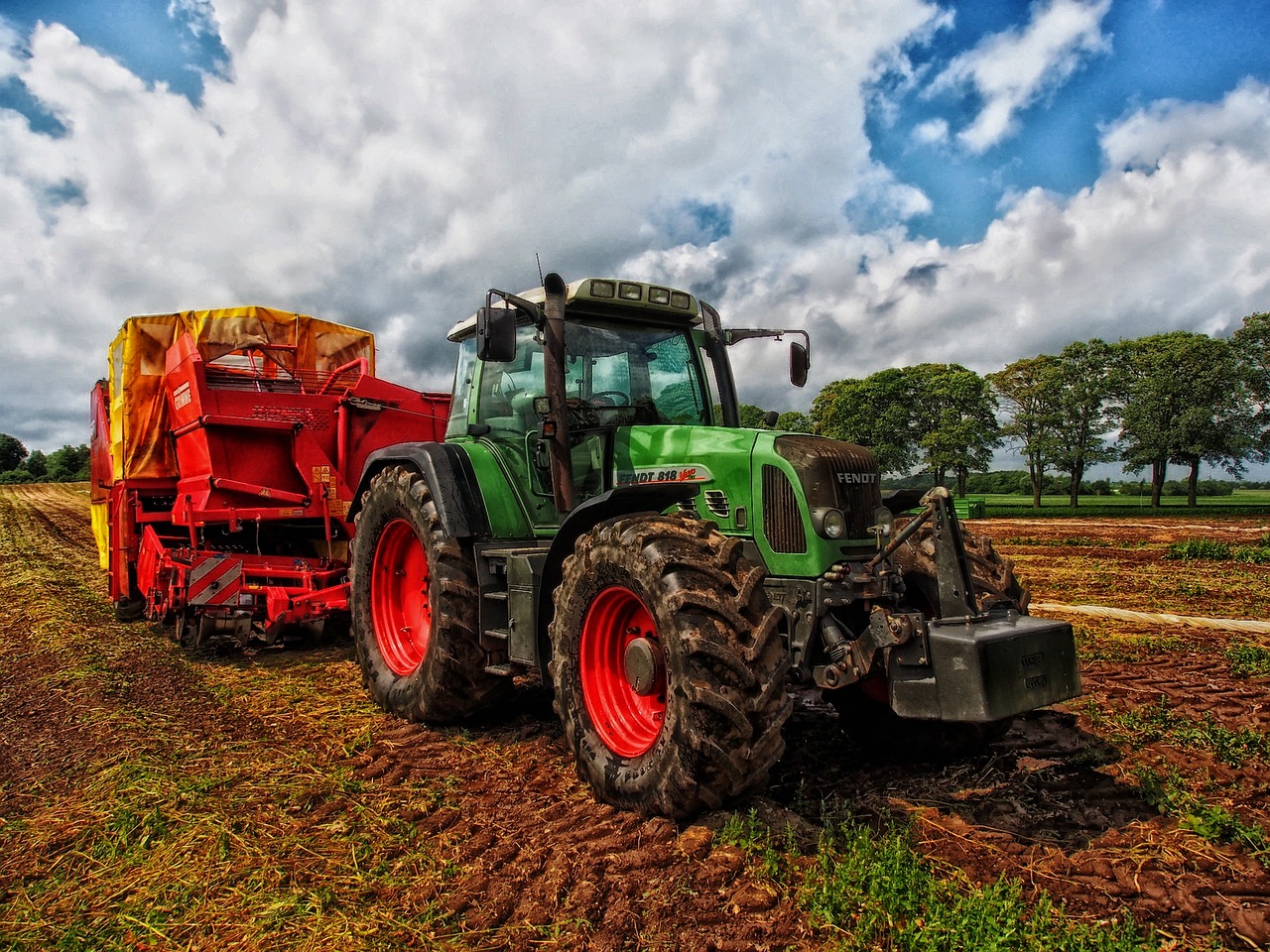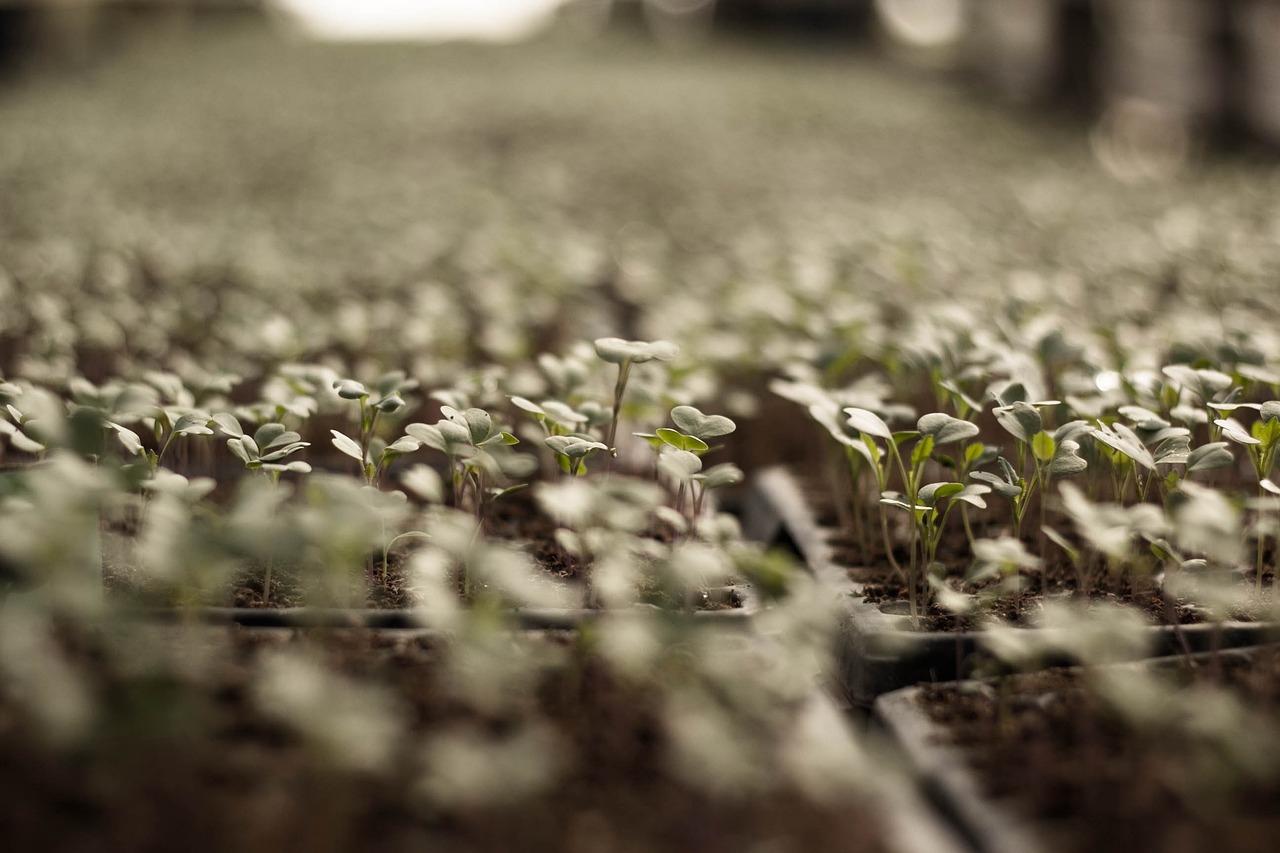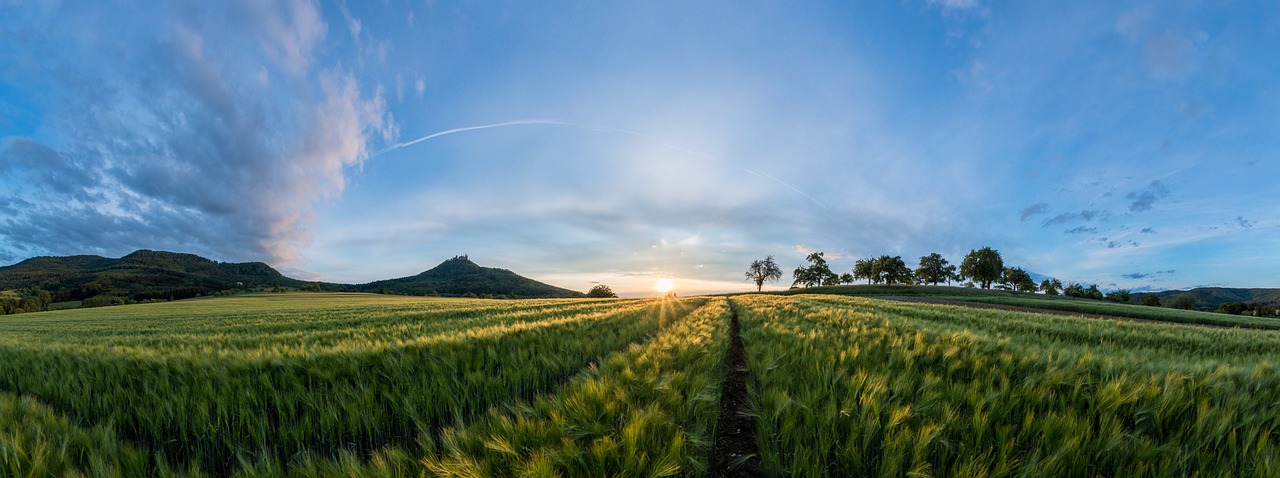What is Regenerative Agriculture?
Regenerative agriculture is not just another farming trend—it's a holistic approach that aims to improve the health of our planet while producing food. Imagine a farming system that works in harmony with nature, rather than against it. This innovative method focuses on restoring the soil, enhancing biodiversity, and promoting ecosystem resilience. It’s like giving Mother Nature a helping hand, allowing her to thrive while we reap the benefits of sustainable food production.
The core idea behind regenerative agriculture is to move away from conventional practices that often degrade the land and its resources. Instead, it emphasizes the importance of nurturing the soil and the surrounding ecosystem. By doing so, farmers can create a self-sustaining system that not only yields crops but also contributes positively to the environment. Think of it as a cycle of life—where healthy soil produces healthy plants, which in turn support diverse wildlife and contribute to a balanced ecosystem.
At its heart, regenerative agriculture is built on several key principles:
- Soil Health: The foundation of regenerative practices, focusing on improving soil structure and fertility.
- Biodiversity: Encouraging a variety of plants and animals to create a resilient farming system.
- Water Management: Utilizing techniques that enhance water retention and reduce runoff.
- Carbon Sequestration: Capturing carbon dioxide from the atmosphere and storing it in the soil.
These principles are not just theoretical; they are backed by a growing body of research and practical applications. Farmers who adopt regenerative practices often report not only healthier crops but also a more vibrant ecosystem on their farms. It’s like turning back the clock to a time when agriculture was more in tune with the natural world. By embracing regenerative agriculture, we can pave the way for a sustainable future where food production does not come at the expense of our planet.
In the following sections, we will delve deeper into the principles of regenerative agriculture, explore its numerous benefits, and discuss the challenges farmers may face when transitioning to these practices. Get ready to discover how regenerative agriculture can transform our approach to farming and contribute to a healthier planet!

Principles of Regenerative Agriculture
Understanding the core principles of regenerative agriculture is essential for farmers who aspire to implement practices that not only restore soil health but also enhance biodiversity and improve the resilience of agricultural systems. At its heart, regenerative agriculture focuses on working with nature rather than against it, promoting a holistic approach to farming that can yield benefits for both the environment and the farmer.
One of the foundational principles is the emphasis on soil health. Healthy soil is alive; it’s a complex ecosystem teeming with microorganisms, fungi, and other forms of life. When farmers prioritize soil health, they create a thriving environment for these organisms, which in turn enhances nutrient availability for plants. This leads to stronger crops that can withstand pests and diseases more effectively. The cycle of life in the soil is akin to a bustling city, where each organism plays a crucial role in maintaining the overall health and productivity of the community.
Another key principle is the promotion of biodiversity. When farmers diversify their crops and incorporate various species into their systems, they create a more resilient ecosystem. This diversity acts like a safety net; if one crop fails, others can still thrive, ensuring food security. Furthermore, a diverse range of plants attracts beneficial insects and wildlife, which can help control pest populations naturally. Imagine a vibrant garden filled with different flowers, each attracting unique pollinators—this is the essence of biodiversity in agriculture.
Additionally, regenerative agriculture emphasizes the importance of perennial crops and agroforestry. By integrating trees and shrubs into farming systems, farmers can enhance soil structure, reduce erosion, and promote carbon sequestration. Perennial plants, unlike annuals, do not need to be replanted every year, which means less soil disturbance and more stable ecosystems. Think of these perennials as the backbone of a healthy farm, providing long-term benefits and stability.
Furthermore, holistic management is a principle that encourages farmers to consider the entire ecosystem when making decisions. This means looking at the interactions between soil, water, plants, and animals, and understanding how changes in one area can affect the others. By adopting a systems-thinking approach, farmers can make informed choices that promote sustainability and resilience. It’s like being a conductor of an orchestra, where each section must work in harmony to create beautiful music.
Lastly, community engagement plays a vital role in regenerative agriculture. Farmers are encouraged to collaborate with local communities, sharing knowledge and resources. This not only strengthens the agricultural community but also fosters a sense of stewardship for the land. When farmers work together, they can advocate for policies that support sustainable practices and create a more resilient food system.
In summary, the principles of regenerative agriculture are interconnected and work synergistically to create a sustainable future for farming. By focusing on soil health, promoting biodiversity, integrating perennial crops, practicing holistic management, and engaging with communities, farmers can cultivate a resilient agricultural system that benefits everyone.
- What is regenerative agriculture? Regenerative agriculture is a farming practice that focuses on restoring and enhancing the health of soil, biodiversity, and ecosystems.
- How does regenerative agriculture improve soil health? It improves soil health by promoting microbial diversity, enhancing nutrient cycling, and reducing soil erosion through practices like cover cropping and reduced tillage.
- What are the economic benefits of regenerative agriculture? While there may be initial costs, regenerative practices often lead to increased crop yields, reduced input costs, and improved resilience against climate change.
- Can I transition to regenerative agriculture on my farm? Yes! Many resources and educational programs are available to help farmers transition to regenerative practices successfully.

Benefits of Regenerative Practices
Regenerative agriculture is not just a buzzword; it's a transformative approach that can significantly enhance our farming practices and the environment. By focusing on the health of the soil, the ecosystem, and the community, regenerative practices offer a plethora of benefits that go beyond mere crop yields. So, what exactly are these benefits, and why should farmers consider making the shift?
First and foremost, one of the standout advantages of regenerative agriculture is its capacity to increase soil fertility. Healthy soil is the backbone of any successful farming operation. Regenerative practices, such as cover cropping and composting, enrich the soil with organic matter and nutrients, leading to enhanced crop production. This is not just about growing more food; it’s about growing better food. When the soil is alive with microorganisms and nutrients, plants can thrive, resulting in healthier produce.
Another significant benefit is improved water retention. In a world where water scarcity is becoming a pressing issue, regenerative agriculture shines by enhancing the soil's ability to absorb and retain water. Practices like mulching and no-till farming create a protective layer on the soil surface, reducing evaporation and runoff. This means that during dry spells, farmers have a better chance of maintaining moisture levels in their fields, ultimately leading to more resilient crops.
Moreover, regenerative agriculture plays a crucial role in carbon sequestration. By promoting practices that increase organic matter in the soil, such as agroforestry and rotational grazing, farmers can capture carbon dioxide from the atmosphere and store it in the ground. This process not only helps combat climate change but also improves soil structure and fertility. Imagine a farm that not only feeds people but also contributes to the fight against global warming—this is the promise of regenerative agriculture.
In addition to these environmental benefits, regenerative practices also enhance biodiversity. By incorporating a variety of crops and livestock, farmers can create a more balanced ecosystem. This diversity helps control pests naturally, reduces the need for chemical inputs, and fosters resilience against diseases. A farm that resembles a mini-ecosystem is not just visually appealing; it’s a powerhouse of productivity and sustainability.
To further illustrate the benefits of regenerative practices, consider the following table:
| Benefit | Description |
|---|---|
| Increased Soil Fertility | Enhances nutrient availability and promotes healthy plant growth. |
| Improved Water Retention | Boosts the soil's capacity to hold moisture, reducing irrigation needs. |
| Carbon Sequestration | Captures atmospheric CO2, helping mitigate climate change. |
| Biodiversity Enhancement | Fosters a balanced ecosystem that naturally controls pests and diseases. |
In summary, the benefits of regenerative practices are profound and far-reaching. They not only improve agricultural productivity but also contribute to a healthier planet. As we face challenges like climate change and food insecurity, embracing these practices could be our ticket to a sustainable future. So, why wait? The time to transition to regenerative agriculture is now!
- What is regenerative agriculture? Regenerative agriculture is a holistic farming approach that focuses on restoring and enhancing the health of the soil, ecosystem, and community.
- How does regenerative agriculture improve soil health? It improves soil health by increasing organic matter, enhancing microbial diversity, and promoting nutrient cycling through practices like cover cropping and composting.
- Can regenerative agriculture help combat climate change? Yes, by sequestering carbon in the soil, regenerative agriculture can play a significant role in mitigating climate change.
- What are some common regenerative practices? Common practices include cover cropping, crop rotation, agroforestry, and holistic grazing.

Soil Health Improvement
When we talk about regenerative agriculture, one of the most exciting aspects is its focus on . Imagine the soil as the foundation of a house; if the foundation is weak, the entire structure is at risk. Healthy soil is teeming with life, rich in nutrients, and capable of supporting robust plant growth. This is crucial because healthy plants not only feed us but also support entire ecosystems. So, how do we improve soil health? Let’s dive in!
First off, regenerative agriculture emphasizes the importance of microbial diversity. Healthy soil is like a bustling city, filled with different organisms working together. These microorganisms break down organic matter, making nutrients available for plants. The more diverse the soil life, the better the nutrient cycling. Think of it as a team of specialists, each playing a unique role in maintaining the health of the soil. For instance, certain bacteria fix nitrogen, while fungi help with nutrient absorption.
Another essential practice is the incorporation of organic matter. Adding compost or cover crops not only improves soil structure but also enhances its ability to retain moisture. This is particularly important in times of drought. When soil is rich in organic matter, it acts like a sponge, soaking up water and releasing it slowly to plants. It’s a win-win situation: farmers get to grow healthier crops, and the environment benefits from reduced runoff and erosion.
To illustrate the impact of soil health improvement, consider the following table:
| Aspect | Benefits of Healthy Soil |
|---|---|
| Nutrient Availability | Improved growth and yield of crops |
| Water Retention | Reduced irrigation needs and drought resilience |
| Biodiversity | Enhanced ecosystem stability and pest resistance |
| Carbon Sequestration | Mitigation of climate change effects |
Moreover, the concept of soil health goes beyond just the physical properties; it also includes chemical and biological aspects. Healthy soil has a balanced pH and nutrient levels, ensuring that plants can absorb what they need without any toxic buildup. Just like a balanced diet is essential for our health, balanced soil chemistry is crucial for plant vitality.
Lastly, let’s not overlook the role of cover cropping in soil health improvement. By planting cover crops during the off-season, farmers can prevent erosion, suppress weeds, and enhance soil structure. These crops, such as clover or rye, act like a protective blanket over the soil, preventing it from washing away and enriching it with organic matter as they decompose. It’s like a natural fertilizer that keeps on giving!
In summary, improving soil health is not just about adding nutrients; it’s about creating a thriving ecosystem beneath our feet. By focusing on microbial diversity, organic matter, and sustainable practices like cover cropping, we can foster healthier soils that support not just our crops, but the entire environment. So, are you ready to dig deeper into the world of regenerative agriculture?
- What is regenerative agriculture? Regenerative agriculture is a holistic farming approach that focuses on restoring and enhancing soil health, biodiversity, and ecosystem resilience.
- How does soil health affect crop yield? Healthy soil improves nutrient availability, water retention, and supports plant growth, leading to higher crop yields.
- What are cover crops, and why are they important? Cover crops are plants grown during the off-season to protect and enrich the soil, preventing erosion and enhancing soil structure.
- Can regenerative agriculture help combat climate change? Yes, by improving soil health and increasing carbon sequestration, regenerative practices can mitigate climate change effects.

Cover Cropping
Cover cropping is a transformative practice in regenerative agriculture that serves multiple purposes, all aimed at enhancing soil health and promoting biodiversity. Imagine a blanket of green that not only protects the soil but also enriches it. By planting specific crops during the off-season, farmers can prevent soil erosion, improve soil structure, and enhance nutrient cycling. This practice is like giving the soil a well-deserved rest while simultaneously preparing it for the next planting season.
One of the most significant advantages of cover cropping is its ability to combat soil erosion. When fields are left bare, rain and wind can wash away precious topsoil, which is the lifeblood of any farm. Cover crops, such as clover or rye, act as a protective layer, holding the soil in place and reducing runoff. This is crucial, especially in areas prone to heavy rainfall. The roots of these cover crops dig deep into the soil, creating channels that improve water infiltration and reduce compaction. It's like having a natural sponge that absorbs water and nutrients, making them available for future crops.
Moreover, cover crops play a vital role in nutrient cycling. As these plants grow, they absorb nutrients from the soil, and when they decompose, they release these nutrients back into the ground, enriching it for the next crop. This natural process reduces the need for synthetic fertilizers, which can harm the environment and degrade soil health over time. Additionally, certain cover crops, like legumes, have the unique ability to fix nitrogen in the soil, making it more fertile and supporting healthier crop growth. It’s a win-win situation that benefits both the farmer and the ecosystem.
Incorporating cover crops into a farming system is not merely a trend; it's a strategic move towards sustainability. Farmers who adopt this practice often report improved yields and healthier crops, which can lead to increased profitability. However, transitioning to cover cropping does require some planning and investment. Farmers need to select the right types of cover crops that suit their specific soil conditions and climate. This decision can be likened to choosing the right teammates for a sports team—each player (or crop) brings unique strengths to the field.
To further illustrate the benefits of cover cropping, consider the following table that outlines some common cover crops and their specific advantages:
| Cover Crop | Benefits |
|---|---|
| Rye | Prevents erosion, improves soil structure, and suppresses weeds. |
| Crimson Clover | Fixes nitrogen, enhances soil fertility, and attracts beneficial insects. |
| Vetch | Improves soil health, provides ground cover, and adds organic matter. |
In conclusion, cover cropping is more than just a farming technique; it’s a holistic approach to agriculture that nurtures the land, enhances biodiversity, and promotes sustainable practices. By understanding and implementing cover cropping, farmers can create a resilient agricultural system that benefits both their crops and the environment. So, why not consider adding a cover crop or two to your farming practices? It could be the game-changer you’ve been looking for!
Q: What are cover crops?
A: Cover crops are plants grown during the off-season to protect and enrich the soil. They help prevent erosion, improve soil health, and enhance nutrient cycling.
Q: How do cover crops improve soil health?
A: Cover crops improve soil health by preventing erosion, enhancing nutrient cycling, and increasing organic matter through decomposition.
Q: Can cover crops reduce the need for fertilizers?
A: Yes, certain cover crops, particularly legumes, can fix nitrogen in the soil, reducing the need for synthetic fertilizers and improving soil fertility.
Q: What types of cover crops should I use?
A: The choice of cover crops depends on your specific soil conditions and climate. Common options include rye, clover, and vetch, each offering unique benefits.

Crop Rotation
Crop rotation is a fundamental practice in regenerative agriculture that involves alternating the types of crops grown on a particular piece of land over several seasons. This technique is not just a simple change of pace; it’s like a well-choreographed dance that helps maintain the health of the soil while optimizing the productivity of the farm. By rotating crops, farmers can disrupt pest and weed cycles, which often thrive when the same crop is planted year after year. Imagine planting the same flower in your garden every season; eventually, pests that love that flower will take over, right? The same principle applies to crops!
One of the key benefits of crop rotation is its ability to enhance soil fertility. Different crops have varying nutrient requirements and contribute different organic matter to the soil. For instance, legumes such as beans and peas can fix nitrogen in the soil, enriching it for subsequent crops. This natural process reduces the need for synthetic fertilizers, which can be harmful to the environment. It’s like having a friend who always brings a delicious dish to a potluck, enhancing the overall meal without you having to spend extra time cooking!
Moreover, crop rotation can significantly improve soil structure and health. By alternating deep-rooted and shallow-rooted plants, farmers can promote better soil aeration and water infiltration. This is crucial for preventing soil erosion and maintaining moisture levels, especially in dry seasons. In essence, crop rotation acts as a natural buffer against the unpredictability of weather patterns, making farms more resilient.
To illustrate the impact of crop rotation, consider the following table that outlines a simple three-year crop rotation plan:
| Year | Crop Type | Benefits |
|---|---|---|
| Year 1 | Corn | Deep-rooted plant that can help break up compacted soil. |
| Year 2 | Legumes (e.g., beans or peas) | Fixes nitrogen in the soil, enhancing fertility for the next crop. |
| Year 3 | Root Vegetables (e.g., carrots or beets) | Helps improve soil structure and aeration with their deep roots. |
In addition to these benefits, crop rotation can also promote biodiversity on the farm. By planting a variety of crops, farmers can create a more diverse ecosystem that attracts beneficial insects and wildlife. This diversity can help keep pest populations in check and reduce the reliance on chemical pesticides. Think of it as creating a balanced ecosystem where every element plays a role in maintaining harmony.
While the advantages of crop rotation are clear, it’s important to note that successful implementation requires careful planning and knowledge of the specific crops being grown. Farmers need to consider factors such as soil type, climate, and market demand when designing their crop rotation schedules. But with a little effort and education, the rewards can be substantial, leading to healthier soils, increased yields, and a more sustainable farming future.
- What is crop rotation? Crop rotation is the practice of growing different types of crops in the same area across a sequence of seasons.
- How does crop rotation improve soil health? It enhances soil fertility, structure, and microbial diversity, reducing the need for chemical fertilizers.
- Can crop rotation help with pest control? Yes, by disrupting pest cycles, crop rotation can reduce pest populations and improve crop yields.
- What crops are best for rotation? Legumes, root vegetables, and grains are commonly used in rotation plans, each offering unique benefits to the soil.

Biodiversity Enhancement
Biodiversity enhancement is a cornerstone of regenerative agriculture, and it plays a pivotal role in creating resilient ecosystems. By promoting a diverse range of species in farming systems, we not only support the health of the environment but also improve the productivity and sustainability of agricultural practices. Imagine a vibrant tapestry of life where different plants, insects, and animals coexist harmoniously—this is what regenerative agriculture aims to achieve. The integration of various species can lead to a multitude of benefits, such as improved soil health, natural pest control, and increased resilience to climate change.
In regenerative agriculture, the inclusion of diverse crops and agroforestry practices can significantly enhance biodiversity. For instance, planting cover crops alongside main crops can create habitats for beneficial insects, which in turn help control pest populations naturally. This practice not only reduces the need for chemical pesticides but also fosters a balanced ecosystem. Furthermore, incorporating trees and shrubs into farming systems can provide shade, reduce soil erosion, and enhance the overall landscape, making it more inviting for various wildlife species.
To illustrate the impact of biodiversity on farming, consider the following table, which outlines the benefits of diverse planting practices:
| Benefit | Description |
|---|---|
| Soil Health | Diverse root systems improve soil structure and nutrient cycling. |
| Pest Management | Natural predators thrive in diverse environments, reducing pest populations. |
| Pollination | A variety of flowering plants attracts a range of pollinators, enhancing crop yields. |
| Climate Resilience | Diverse ecosystems are better equipped to withstand extreme weather events. |
Moreover, enhancing biodiversity is not just an environmental concern; it has profound implications for food security. With a wider variety of crops and livestock, farmers can better adapt to changing market demands and environmental conditions. This adaptability is crucial in a world where climate change poses significant risks to traditional farming practices. By embracing biodiversity, farmers can create a more resilient food system that meets the needs of future generations.
However, achieving biodiversity enhancement requires a shift in mindset among farmers and stakeholders. It involves recognizing the value of every species in the ecosystem and understanding that a diverse agricultural landscape is not just beneficial but essential for long-term sustainability. Education and community support play vital roles in this transition, empowering farmers to experiment with new practices and share their successes.
- What is biodiversity enhancement in agriculture?
Biodiversity enhancement in agriculture refers to practices that increase the variety of plants, animals, and microorganisms in farming systems, promoting ecological balance and resilience.
- How does biodiversity benefit farming?
Biodiversity benefits farming by improving soil health, enhancing pest control, increasing resilience to climate change, and boosting overall productivity.
- What practices can enhance biodiversity?
Practices such as cover cropping, crop rotation, agroforestry, and intercropping can significantly enhance biodiversity on farms.
- Why is biodiversity important for food security?
Biodiversity is crucial for food security as it allows farmers to adapt to changing conditions, reduces dependency on single crops, and ensures a stable supply of diverse food sources.

Challenges in Adoption
While regenerative agriculture is a beacon of hope for sustainable farming, it's not without its challenges. Farmers looking to transition from conventional practices to regenerative methods often encounter a myriad of obstacles that can hinder their progress. One of the most significant hurdles is the economic barrier. Transitioning to regenerative practices often requires an initial investment in new equipment, seeds, and training. Many farmers, especially those operating on tight margins, may find it difficult to allocate funds for these changes. The financial strain can lead to hesitation, as they weigh the potential benefits against the immediate costs.
Additionally, the market access for regenerative products can pose a challenge. While consumer demand for sustainably produced food is growing, not all markets are fully equipped to support regenerative agriculture. Farmers might struggle to find buyers willing to pay a premium for their products, which can discourage them from making the switch. Without a robust market, the incentive to adopt these practices diminishes significantly.
Another challenge lies in the knowledge gap. Many farmers may not be aware of the principles and practices of regenerative agriculture, or they may lack access to educational resources that can guide them through the transition. This lack of knowledge can create a cycle of resistance to change, as farmers may feel overwhelmed by the prospect of altering their long-established farming methods. To address this, it's crucial to provide comprehensive training programs and resources that can empower farmers with the skills they need to succeed.
Resistance to change within traditional farming communities can also be a significant barrier. Farming has deep cultural roots, and many farmers are hesitant to abandon practices that have been passed down through generations. This cultural inertia can create a challenging environment for those who wish to adopt regenerative practices. To overcome this, it's important to foster a sense of community and support among farmers, encouraging them to share their experiences and successes in regenerative agriculture.
In summary, while the transition to regenerative agriculture is fraught with challenges, understanding these barriers is the first step toward overcoming them. By addressing economic considerations, enhancing market access, providing educational resources, and fostering a supportive community, we can pave the way for a more resilient and sustainable agricultural future.
- What is regenerative agriculture? Regenerative agriculture is a holistic farming approach that focuses on restoring soil health, enhancing biodiversity, and improving the resilience of agricultural systems.
- What are the main benefits of regenerative agriculture? The benefits include increased soil fertility, improved water retention, enhanced carbon sequestration, and a healthier ecosystem.
- What challenges do farmers face when adopting regenerative practices? Farmers may encounter economic barriers, lack of knowledge, and resistance to change from traditional farming communities.
- How can farmers overcome these challenges? By accessing educational resources, finding supportive markets, and building community networks, farmers can successfully transition to regenerative practices.

Economic Considerations
When it comes to adopting regenerative agriculture, one of the biggest hurdles farmers face is the economic aspect. Transitioning to these sustainable practices often requires an upfront investment that can be daunting, especially for small-scale farmers. It's like deciding to renovate your house; you know it will pay off in the long run, but the initial costs can make you hesitate. Farmers need to consider not only the financial implications but also the potential long-term benefits that regenerative practices can bring to their operations.
Initial investments can include costs for cover crops, new equipment, and training programs. These expenses can pile up quickly, leading to a significant financial strain. However, the good news is that many regenerative practices can lead to reduced input costs over time. For instance, by improving soil health, farmers may find they need fewer chemical fertilizers and pesticides, ultimately saving money. It's a bit like investing in a high-quality pair of shoes; while they may cost more upfront, they save you money in the long run by lasting longer and requiring fewer replacements.
Additionally, market access for regenerative products is another economic consideration. As consumer awareness about sustainability grows, so does the demand for organic and regeneratively produced food. Farmers who transition to regenerative practices can tap into this burgeoning market, potentially fetching higher prices for their products. This shift can be seen as a golden opportunity, akin to catching the wave of a new trend that promises to bring in more customers.
To help farmers navigate these economic challenges, supportive policies and incentives are crucial. Governments and organizations can play a pivotal role by providing financial assistance, grants, or subsidies aimed at promoting regenerative practices. Imagine a farmer receiving a grant that covers the cost of their cover crops or a low-interest loan to purchase new equipment. Such support can make all the difference in a farmer's decision to transition.
Moreover, educational resources and training programs can help farmers understand the economic benefits of regenerative agriculture. By equipping them with the knowledge and skills needed, farmers can make informed decisions that not only enhance their productivity but also their profitability. It's like having a coach who guides you through the best strategies to win the game.
In conclusion, while the economic considerations surrounding regenerative agriculture can be challenging, they are not insurmountable. With the right support, knowledge, and market access, farmers can successfully transition to regenerative practices that yield both environmental and economic benefits.
- What is regenerative agriculture? Regenerative agriculture is a holistic farming approach that focuses on restoring soil health, enhancing biodiversity, and improving ecosystem resilience.
- How does regenerative agriculture benefit the environment? It improves soil fertility, increases water retention, and enhances carbon sequestration, contributing to a healthier environment.
- What are some common practices in regenerative agriculture? Common practices include cover cropping, crop rotation, and agroforestry.
- What challenges do farmers face when adopting regenerative practices? Economic barriers, lack of knowledge, and resistance to change within traditional farming communities are some of the challenges.
- How can farmers access support for transitioning to regenerative agriculture? Farmers can seek financial assistance, grants, and educational resources from governments and organizations dedicated to promoting sustainable farming.

Educational Resources
Transitioning to regenerative agriculture can feel like stepping into a new world for many farmers, and that’s where play a crucial role. Imagine trying to navigate a maze without a map; that’s what it can be like for farmers who are unfamiliar with regenerative practices. Fortunately, a plethora of resources is available to guide them through this journey. From online courses to local workshops, farmers can access a wealth of information that empowers them to make informed decisions.
One of the most effective ways to learn about regenerative agriculture is through community-supported learning. Many agricultural extension services offer programs that connect farmers with experts in the field. These programs often include:
- Hands-on workshops that allow farmers to practice new techniques.
- Field days where they can see regenerative practices in action.
- Networking opportunities with other farmers who are making the transition.
Moreover, online platforms have become invaluable tools for education. Websites like Regeneration International and The Rodale Institute provide a treasure trove of resources, including:
- Webinars that cover a variety of topics related to regenerative farming.
- Case studies showcasing successful transitions to regenerative practices.
- Research articles that delve into the science behind regenerative agriculture.
Additionally, social media groups and forums can serve as informal classrooms where farmers share their experiences, challenges, and successes. These platforms foster a sense of community and support, which is essential when embarking on a new agricultural journey.
For those who prefer a more structured approach, universities and agricultural colleges are beginning to offer formal courses on regenerative agriculture. These programs often combine theoretical knowledge with practical applications, equipping farmers with the skills they need to implement regenerative practices effectively. Some institutions even provide certification programs that can enhance a farmer's credibility in the marketplace.
To further support farmers, it’s essential for government and non-profit organizations to provide financial incentives and grants aimed at education and training in regenerative practices. This financial support can alleviate some of the initial barriers to entry, making it easier for farmers to invest in their education and the future of sustainable agriculture.
In conclusion, the transition to regenerative agriculture is not just about changing farming practices; it's about equipping farmers with the right tools and knowledge to thrive in a sustainable way. By leveraging educational resources and community support, farmers can confidently navigate their path toward regenerative practices, ultimately contributing to a healthier planet and a more resilient agricultural system.
Q1: What is regenerative agriculture?
A1: Regenerative agriculture is a farming approach that focuses on restoring soil health, enhancing biodiversity, and improving ecosystem resilience through practices like cover cropping, crop rotation, and agroforestry.
Q2: How can I learn more about regenerative agriculture?
A2: There are numerous resources available, including online courses, workshops, and community programs. Websites such as Regeneration International and The Rodale Institute offer valuable information and training.
Q3: What are the main benefits of regenerative agriculture?
A3: Regenerative agriculture improves soil fertility, enhances water retention, increases biodiversity, and contributes to carbon sequestration, creating a healthier environment and sustainable food production.
Q4: Are there any financial incentives for adopting regenerative practices?
A4: Yes, many government and non-profit organizations provide grants and financial support to help farmers implement regenerative practices and cover the costs of education and training.
Frequently Asked Questions
- What is regenerative agriculture?
Regenerative agriculture is a holistic approach to farming that focuses on restoring and enhancing the health of the soil, biodiversity, and ecosystems. It aims to create resilient agricultural systems that can thrive without depleting natural resources.
- How does regenerative agriculture improve soil health?
By implementing practices such as cover cropping and crop rotation, regenerative agriculture enhances soil structure, increases nutrient availability, and promotes microbial diversity, all of which contribute to healthier, more productive soil.
- What are the benefits of regenerative agriculture?
Regenerative agriculture offers numerous benefits, including increased soil fertility, improved water retention, enhanced carbon sequestration, and greater resilience against pests and diseases, ultimately leading to sustainable food production.
- What practices are commonly used in regenerative agriculture?
Common practices include cover cropping, crop rotation, agroforestry, and holistic grazing. These methods help to restore soil health, promote biodiversity, and improve ecosystem resilience.
- What challenges do farmers face when adopting regenerative agriculture?
Farmers may encounter economic barriers, such as initial investment costs, lack of access to markets for regenerative products, and resistance to change within traditional farming communities.
- How can farmers learn about regenerative agriculture?
Access to educational resources, training programs, and workshops is crucial for farmers looking to transition to regenerative practices. These resources equip them with the knowledge and skills necessary for successful implementation.
- Is regenerative agriculture more expensive than conventional farming?
While there may be initial costs associated with transitioning to regenerative practices, many farmers find that the long-term benefits, such as improved soil health and reduced input costs, outweigh these expenses.
- Can regenerative agriculture help combat climate change?
Yes! Regenerative agriculture plays a significant role in climate change mitigation by enhancing carbon sequestration in soils and promoting practices that reduce greenhouse gas emissions.
- How does biodiversity play a role in regenerative agriculture?
Biodiversity is crucial in regenerative agriculture as it strengthens ecosystems, increases resilience against pests and diseases, and promotes a more balanced and sustainable agricultural system.



















